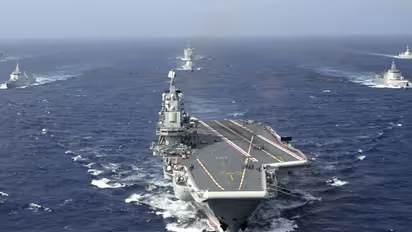Bombshell satellite images indicate China working on nuclear reactor for new aircraft carrier; see pics

Synopsis
China has built a land-based prototype nuclear reactor for a large surface warship, in the clearest sign yet that Beijing is advancing toward producing its first nuclear-powered aircraft carrier.
China has achieved a major milestone in naval technology, developing a prototype nuclear reactor intended for large surface warships—a strategic move widely seen as laying the groundwork for the nation’s first nuclear-powered aircraft carrier. The Associated Press reports that a recently published research paper reveals China’s ambitious plans, with experts suggesting this step could reshape Beijing’s influence on the high seas.
In-depth analysis by the Middlebury Institute of International Studies, which included scrutinizing recent satellite imagery and Chinese government documents, confirmed that China is progressing toward a nuclear propulsion system suitable for a carrier-class vessel.
Constructed amid the mountainous landscapes near Leshan in Sichuan province, this prototype reactor reflects China’s unwavering commitment to building a navy that could potentially challenge longstanding maritime powers.
Currently, the People’s Liberation Army Navy (PLAN) boasts the world’s largest fleet in terms of ship count. Should nuclear-powered carriers join its ranks, PLAN would gain unprecedented blue-water capabilities, allowing it to project power across distant seas rather than being restricted to China’s coastal waters. Nuclear carriers, as demonstrated by the US Navy, can sustain operations over vast distances without refueling, freeing up space for additional weaponry and aircraft fuel.
With only the United States and France operating nuclear-powered carriers—America’s fleet of eleven carriers ensures a robust presence in strategic waters like the Indo-Pacific—China’s pursuit of nuclear-powered carriers signals both a response to US naval dominance and a clear ambition to assert global influence.
In a recent congressional report, the Pentagon acknowledged the challenge posed by China’s modernizing military, noting China’s intensified focus on “increasing demands” for its fleet to venture farther from home waters.
China’s current fleet includes three aircraft carriers, the most recent being the Type 003 Fujian, launched in 2022. Departing from previous Soviet-inspired designs, the Fujian is China’s first indigenous carrier, equipped with electromagnetic catapults akin to those used by the US Navy.
However, the Fujian remains conventionally powered, limiting its operational range compared to its nuclear-powered counterparts. Following successful sea trials, the Fujian is set to undergo additional tests, underscoring China’s methodical approach toward a nuclear-powered fleet.
Initially suspected as a weapons facility
The research team from Middlebury initially believed the site near Leshan to be a facility for nuclear weapon production, AP reports. By examining satellite imagery, public records, and environmental reports—and even citizen complaints about loud construction noise—the team discovered the reactor’s true purpose: it is a prototype naval reactor located in Mucheng township, around 70 miles southwest of Chengdu. Housed in a secure site known as Base 909, this reactor is managed by the Nuclear Power Institute of China under a “national defense designation.”
The paper also revealed procurement records from China’s 701 Institute, which specializes in aircraft carrier development, indicating reactor equipment purchases for a “large surface warship” as part of the Nuclear Power Development Project. This led researchers to conclude that the reactor could power a next-generation carrier, potentially dubbed the Longwei, or Dragon Might.
“Unless China is developing nuclear-powered cruisers, which were pursued only by the United States and the Soviet Union during the Cold War, then the Nuclear Power Development Project most certainly refers to a nuclear-powered aircraft carrier development effort,” the research paper states.
Great Rejuvenation
Chinese President Xi Jinping’s strategic vision of “great rejuvenation,” prioritizes naval expansion and modernization. The South China Sea, Taiwan, and broader Pacific regions are central to this vision, as China looks to extend its maritime influence and counter the US-led naval presence. According to the US Defense Department, this shift marks a departure from China’s traditional focus on coastal defense, embracing instead “protection missions on the far seas,” a clear indication of Beijing’s global aspirations.
Check the Breaking News Today and Latest News from across India and around the world. Stay updated with the latest World News and global developments from politics to economy and current affairs. Get in-depth coverage of China News, Europe News, Pakistan News, and South Asia News, along with top headlines from the UK and US. Follow expert analysis, international trends, and breaking updates from around the globe. Download the Asianet News Official App from the Android Play Store and iPhone App Store for accurate and timely news updates anytime, anywhere.